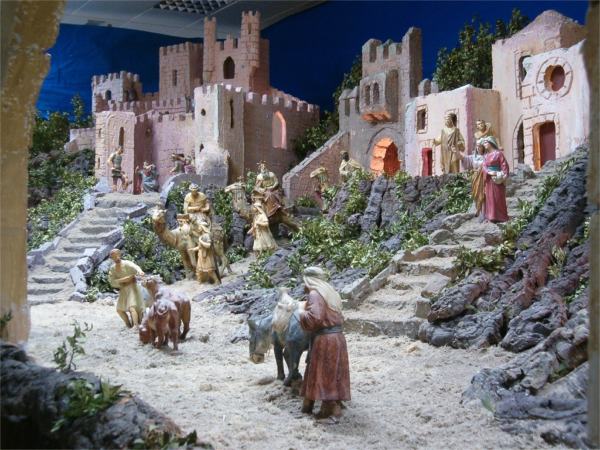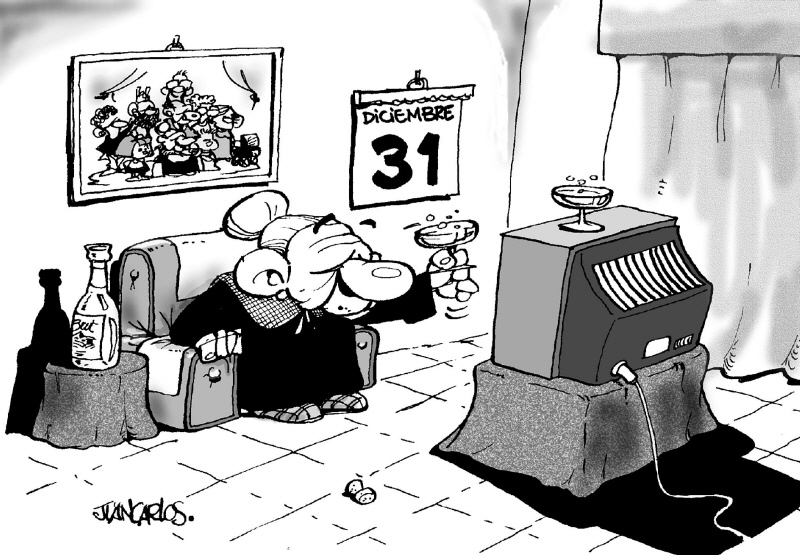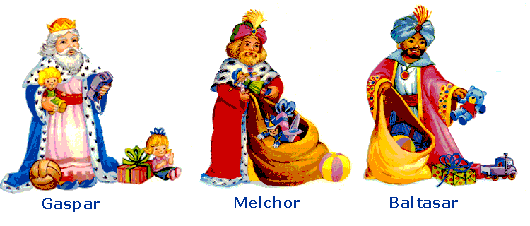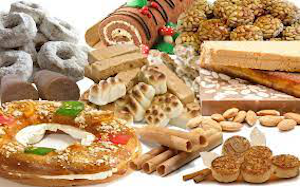HOLIDAY IN THE SUN

What happens in Spain at Christmas

One symbol of Christmas that still maintains much importance throughout Spain is the Nativity scene “Nacimiento”. These scenes occupy plazas in cities and small towns throughout the country, and can also be seen in the doorways and entrances of many Spanish homes, as well in shop windows, and they can be quite elaborate. In many small towns, during the nights just before Christmas, plazas might even have a live Nativity scene, with actors and actresses playing the parts of Mary and Joseph and the three wise men as well as live animals that are often associated with the birth of Christ, like lambs, sheep, and donkeys.
Also during the days leading up to Christmas, children sing in the streets, especially in the villages and small towns of rural Spain, where they still participate in the age old tradition called the “aguinaldo”. Even though not as popular in recent times, in years past one could hear children singing Christmas carols in their neighbourhoods, outside the homes of their neighbours or next to a Nativity scene, and are rewarded with a few sweets sweet or a small cash gift.
December 22, Christmas Lottery Winners are Announced
December 22nd, is an important part of Christmas as it is the day that school breaks up for the Christmas holidays, and perhaps more importantly, they announce the winning number of the world-renowned lottery draw, El Gordo, literally The Fat One. This is a long drawn-out event that unfolds on the morning of December 22nd. Ticket numbers from a giant drum are matched to balls with millionaire prizes in a smaller drum. The ticketing system allows people to buy fractions and sub fractions of different numbers, décimos and participaciones, with increasing chances of a share in the winnings. As the top prizes come out, TV and radio coverage centres on the search for the many winners and for the particular lottery shop where the winning ticket was bought. This tradition is deeply embedded in these holidays, dating back to 1763, when Carlos III initiated it. Since then, not one year has passed without it, and it now is the symbolic moment in which Spaniards begin to celebrate the Christmas holidays.
December 24, Christmas Eve
Christmas Eve in Spain (Nochebuena), is celebrated more so than Christmas Day, and is when the main Christmas meal is taken. The family gathers together in the grandparents’ home, alternating grandparents from one year to another, but all the women and many of the men help in the preparation of the evening meal – a veritable feast – which begins about 10 p.m. and can go on until the small hours. Some sing carols around the crib of the nativity scene which remains without the baby until the stroke of midnight. Other families go to midnight Mass but many in modern-day Spain watch the Christmas programme’s on TV while washing down Christmas sweetmeats of Turrón (nougat) and mantecas (a range of butter-based biscuits) with Cava (Spanish champagne) after their meal. There is a wide variety of typical foods one might find on plates across Spain on this night. Each region has its own distinct specialties. Among typical dishes served on Christmas Eve and during the days that follow are roast lamb and suckling pig (typically served in the regions of Castilla Leon, Castilla la Mancha, and Madrid), turkey or duck (commonly prepared in Andalucia), and an enormous variety of seafood, including shrimp, lobster, crab, and various types of fish like hake, trout, sea bream, sea bass, and salmon (common in many regions, but mostly on the costas). For dessert, there is quite a spread of delicacies, among them are turrón and marzipan, desserts made of honey, egg and almonds that are Arabic in origin, as well as polvorones, and a variety of nuts and dried fruits. To drink, one must have a glass of cava, the Spanish equivalent of champagne, although the Spanish say that cava is much better. After the meal, many Spaniards get their second wind and go to midnight mass, known as “La misa del Gallo”, or “Rooster Mass”, named such because the Rooster is known as the first to announce the birth of Christ.December 25th Christmas Day
Christmas Day and people spend time with their families, they eat another large meal, although not as big as the one the day before but it is another splendid meal served around midday and is shared with family and friends. Spaniards’ love of good food and wine and the leisurely sharing of it and good company is never more indulged than over the festive period. While there is some giving of gifts at Christmas, It is not Santa who comes to Spain bearing gifts, but the Three Wise Men. The Spanish Christmas continues for a few weeks after Dec. 25th. the traditional time of giving and receiving is January the 6th, the Epiphany or “Los Reyes” (“The Kings”), although in many families, children received some gifts from “Papa Noel”, the Spanish equivalent of Santa ClausDecember 28th, Day of the Innocents
December 28 marks a day of celebration exclusively Spanish called the Day of the Innocents (el día de los Santos Inocentes) The day is the anniversary of the murder of many children committed by Herod in Judea, but in modern times it is treated similarly to April’s Fools Day, and many laughs are had on this day, especially by the natives. Many foreigners who are in Spain become very confused as ridiculous or incredible news appears in the newspapers, even local authorities stage baffling practical jokes on their citizens, and friends and acquaintances cannot be trusted for their word. In MÁLAGA on the 28th they celebrate the Fiesta Mayor de Verdiales ——- Los Verdiales are traditional forms of song and dance from rural areas of Málaga province. On December 28th every year there’s a competition in Malaga – Venta San Cayetano del Puerto de la Torre, on the outskirts of of the city, to decide which village troupe sing and dance the best. It is a great excuse for a party and it goes on all night long. Thousands of people turn up. There’s good music, good food and the wine flows freely. It’s like a proper, old-fashioned village festival that takes place in town. It is worth going for the food alone!December 31, New Year’s Eve
New Year’s Eve, or Nochevieja – literally ‘Old Night, is celebrated with family and friends at home or “on the town”. People congregate in every main square throughout the country to wait for the bells which herald in the New Year. When the clock strikes 12, the church bells sound 12 times, and at this moment, all Spaniards eat 12 grapes, The ‘lucky grapes’, las uvas de la suerte, are essential on, la Nochevieja ‘. A tradition introduced in the early 20th century, it’s said to bring good luck if at each stroke of the bells at midnight you take one grape and make one wish, un deseo. Also considered lucky is wearing red underwear on New Year’s Eve. For the New Year, el Año Nuevo. Families and friends stay together for this celebration which marks the end of one year and the beginning of a new one, and in the case of most Spaniards this means a lively celebration will be had until the wee hours of the morning. The dress code for Nochevieja is smart and a collar and tie is obligatory even if it is the only day of the year when one is worn.
In Benalmadena you can see the new year in twice at the wonderful FREE open air party in the plaza mezquita in Arroyo de la Miel, where a big dance band starts performing around 10.00 pm and sees in the British new year and an hour later the Spanish new year. The festivities are attended by the whole family and continue until very, very late.

January 1st is a national holiday.
This the only day of the year when Spanish newspapers are not published.
January 5th, The eve of Three King’s Day
On the evening of January 5, children go to the parade where the three kings arrive in their town, and parade through the streets. In Andalucian towns Including Arroyo de la Miel they throw sweets into the watching crowds. Umbrellas have a dual purpose of protection from the flying sweets and turned upside down, to catch the sweets. Los Reyes (The Kings) is the highlight of the festivities for the children. In the run up to the 6th of January department stores all over the country play host to the Kings, and the children tell them what they would like to receive, and on the fifth the shops remain open until after mid night. Before going to bed the children put their shoes on the door step so that the Kings will know how many children live there. They also put out something to eat and drink for Melchor, Gaspar, and Baltazar, and water and grass for their camels (true, they can last a month or more without drinking water, but that night they have a lot of work to do, so they need extra water and food).
January 6, Los Reyes – Three King’s Day
Here is the biggest difference between Spain and the rest of the world, for while most of us have already begun packing up the Christmas ornaments, thrown out the tree, and found a permanent place for all of our presents, Spaniards are continuing the celebration. The children discover their presents in the morning, in place of the food and drink they had left out, and another feast day commences. For breakfast or after lunch, families often have the typical dessert of the day, the “Roscón de los Reyes”, a large ring shaped cake that is decorated with candied fruits, symbolic of the emeralds and rubies that adorned the robes of the three kings, hidden inside the cake there are surprises “sorpresas”.

January 7th
January 7th, is a rude awakening, back to school and back to work, and the return to everyday life.

USE THESE QUICKLINKS TO NAVIGATE THIS SITE
